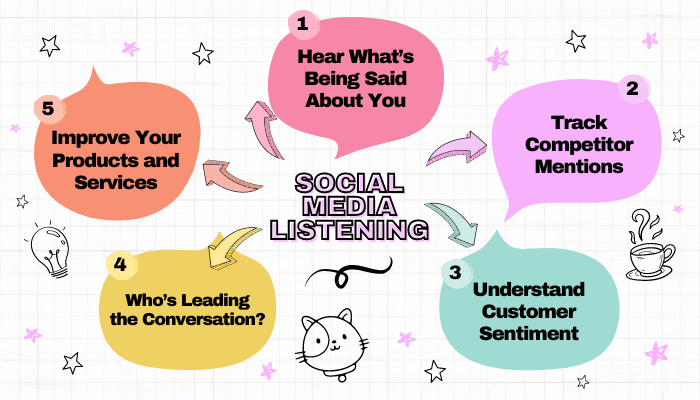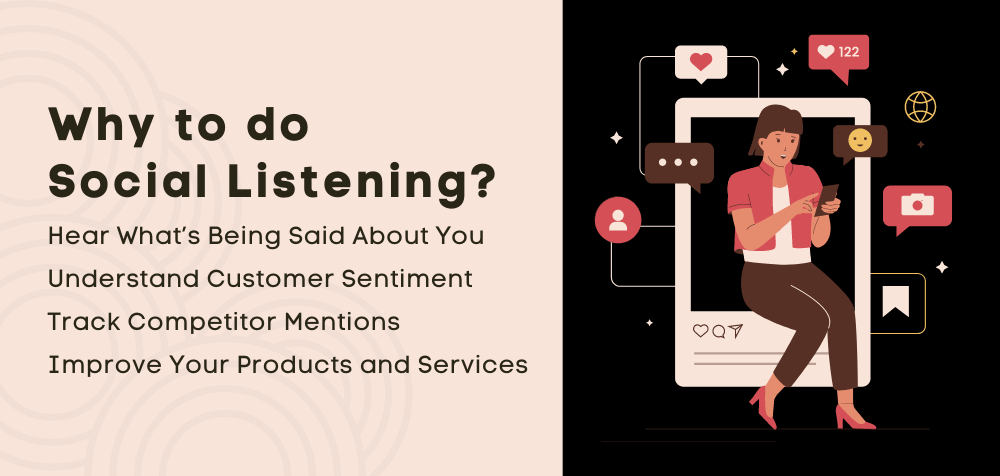Imagine you’re at a party, trying to make conversation. But instead of talking, you just stand there, not listening to what anyone else has to say. Awkward, right? Well, that’s exactly what it’s like for a brand that doesn’t engage in social listening.
In today’s digital world, simply broadcasting your message isn’t enough—you need to be tuned in to what people are saying about you, your industry, and your competitors. That’s where social listening comes in.
What is Social Listening?
Social listening is like having your ear to the ground in the vast world of social media. It’s the practice of monitoring your brand’s social media channels for customer feedback, mentions of your brand, your competitors, or related keywords, and analysing that information to gain insights and take action.
But it’s not just about hearing what people are saying—it’s about truly listening, understanding, and responding in a way that strengthens your brand and builds relationships with your audience.
With social media listening, you can also:
- Track competing brands,
- Monitor trending content and
- Conduct a sentiment analysis on topics meaningful to your business.
Social listening metrics
Businesses gather social listening data using social listening metrics. Here are key metrics to track:
- Reach: The number of people who see a social media post that contains a tracked keyword.
- Engagements: The number of likes, comments, clicks, and shares on an individual post with a tracked keyword.
- Engagement rate: The percentage of users reached who engage with that post, or engagement rate = post engagement / post reach x 100.
- Mentions: The number of times social media users mention a brand or another tracked keyword.
- Share of social voice (SoSV): The percentage of conversations that mention a brand compared to those that mention competing brands, or SoSV = [number of mentions of your brand / (number of mentions of competitor brands + number of mentions of your brand)] x 100
Social sentiment: The distribution of neutral, positive, and negative sentiments expressed for a particular keyword, or social sentiment = (total number of positive mentions – total number of negative mentions) / total number of mentions.

Let’s dive into the nitty-gritty of social listening
Hear What’s Being Said About You
The first step in social listening is to know what people are saying about your brand. Are customers singing your praises, or are they grumbling about a recent product launch? By keeping tabs on brand mentions, you can quickly identify what’s working and what’s not.
Track Competitor Mentions
If you want to stay ahead of the competition, you need to know what they’re up to. Social listening allows you to keep an eye on your competitors and learn from their successes—and their mistakes. Compare your brand’s social media performance with that of your competitors to identify areas for improvement. Are customers complaining about something your competitor isn’t doing right? That’s your chance to swoop in and offer a better solution.
Understand Customer Sentiment
Social listening isn’t just about knowing what people are saying—it’s about understanding how they feel. Are your customers excited, frustrated, or indifferent? By analysing sentiment, you can gain valuable insights into how your brand is perceived. Tools like Mention and Talkwalker can help you analyse the tone of conversations surrounding your brand.
Identify Influencers: Who’s Leading the Conversation?
Influencers can have a massive impact on how your brand is perceived online. By engaging in social listening, you can identify key influencers in your industry and build relationships with them.
- Look for individuals or accounts that frequently engage with your brand or industry and have a significant following.
- Reach out to influencers in a way that feels genuine and aligns with your brand’s values. Collaborate with influencers to amplify your message and reach a wider audience.
Improve Your Products and Services
Your customers are constantly telling you what they want—you just need to listen. Social listening can provide valuable insights into how your products or services are performing and what improvements can be made.
All ears to Social Media
Social listening is more than just a buzzword—it’s a powerful tool that can help you stay connected with your audience, outmanoeuvre your competitors, and continually improve your brand. By monitoring brand mentions, tracking competitors, understanding customer sentiment, identifying influencers, and using feedback to enhance your products and services, you’ll be well on your way to building a stronger, more responsive brand.
So, the next time you’re at that metaphorical party, don’t just stand there—listen, engage, and make your brand the life of the social media conversation.
For further exploration on related subjects, check out our comprehensive articles on Developing Captivating Social Media Content, Leveraging Communities, and Getting through Online Forums and Groups. Each piece delves deeper into the nuances and offers additional insights. Happy reading!


